-
 Iron tsuba with design of a cricket and grass inlaid in brass (suemon-zōgan) and a bridge over a stream in openwork (sukashi) on both sides. Inlay of distant part of the cricket's antenna is missing. Heianjō School. Momoyama period. Diameter: 79.5 mm, thickness at seppa-dai: 3.3 mm NBTHK # 4002100.
Iron tsuba with design of a cricket and grass inlaid in brass (suemon-zōgan) and a bridge over a stream in openwork (sukashi) on both sides. Inlay of distant part of the cricket's antenna is missing. Heianjō School. Momoyama period. Diameter: 79.5 mm, thickness at seppa-dai: 3.3 mm NBTHK # 4002100. -
 Iron tsuba of round form with a dense combination of symbols: slanting rays of light (shakoh) Christian motif (Jesuit's IHS symbol), also often described as "tokei" or "clock gear", wild goose in flight, bracken, and lozenges in openwork (sukashi). Copper sekigane. Edo period.
Iron tsuba of round form with a dense combination of symbols: slanting rays of light (shakoh) Christian motif (Jesuit's IHS symbol), also often described as "tokei" or "clock gear", wild goose in flight, bracken, and lozenges in openwork (sukashi). Copper sekigane. Edo period.Size: 76.0 x 72.6 x 6.2 mm
Unsigned.
For information regarding shakoh tsuba see article 'Kirishitan Ikenie Tsuba by Fred Geyer at Kokusai Tosogu Kai; The 2nd International Convention & Exhibition, October 18-23, 2006, pp. 84-91.
-
 Kabuki actor: Matsumoto Kōshirō V [五代目松本幸四郎] (Japanese, 1764-1838); other names: Ichikawa Komazō III, Ichikawa Sumizō I. Role: Nikki Danjo (仁木弾正): "Evil retainer Nikki Danjo who plots to overthrow his lord in the play Precious incense and the bush clover of Sendai (Meiboku sendai hagi)" [R. Kruml]. Artist: Utagawa Kunisada [歌川 国貞] a.k.a. Utagawa Toyokuni III [三代歌川豊国] (Japanese, 1786 – 1865). Block cutter: Horikō (Kiyomizu) Ryūzō [彫工 柳三]. Publisher: Ebisuya Shoshichi [恵比寿屋庄七], Kinshōdō (Japanese, fl. c. 1846 – 1883). Year: 1863 (Bunkyū 3), 7th month. Size: Vertical ōban, hōsho paper. Signed: Nanajuhassai (aged seventy-eight) Toyokuni ga within toshidama cartouche. Censor’s seal: date-aratame. This print is from a series of portraits that Kunisada undertook very late in life and has been named Kinshodo-ban yakusha okubi-e (Kinshodo’s Large-Head Actor Portraits) in reference to the publisher, Ebisuya Shochochi of Kinshodo. The series depicted great actors in their famous roles from the past and present. Ref.: (1) [LIB-1212.2017] Robert Schaap. Kunisada: Imaging, drama and beauty. — Leiden: Hotei Publishing, 2016, p. 118 and 167 (№ 42):
Kabuki actor: Matsumoto Kōshirō V [五代目松本幸四郎] (Japanese, 1764-1838); other names: Ichikawa Komazō III, Ichikawa Sumizō I. Role: Nikki Danjo (仁木弾正): "Evil retainer Nikki Danjo who plots to overthrow his lord in the play Precious incense and the bush clover of Sendai (Meiboku sendai hagi)" [R. Kruml]. Artist: Utagawa Kunisada [歌川 国貞] a.k.a. Utagawa Toyokuni III [三代歌川豊国] (Japanese, 1786 – 1865). Block cutter: Horikō (Kiyomizu) Ryūzō [彫工 柳三]. Publisher: Ebisuya Shoshichi [恵比寿屋庄七], Kinshōdō (Japanese, fl. c. 1846 – 1883). Year: 1863 (Bunkyū 3), 7th month. Size: Vertical ōban, hōsho paper. Signed: Nanajuhassai (aged seventy-eight) Toyokuni ga within toshidama cartouche. Censor’s seal: date-aratame. This print is from a series of portraits that Kunisada undertook very late in life and has been named Kinshodo-ban yakusha okubi-e (Kinshodo’s Large-Head Actor Portraits) in reference to the publisher, Ebisuya Shochochi of Kinshodo. The series depicted great actors in their famous roles from the past and present. Ref.: (1) [LIB-1212.2017] Robert Schaap. Kunisada: Imaging, drama and beauty. — Leiden: Hotei Publishing, 2016, p. 118 and 167 (№ 42): Ref.: (1) [LIB-1197.2016] Arendie and Henk Herwig. Heroes of the kabuki stage: an introduction to kabuki with retellings of famous plays, illustrated by woodblock prints. — Amsterdam: Hotei Publishing, 2004; pp. 243-249.
Ref.: (1) [LIB-1197.2016] Arendie and Henk Herwig. Heroes of the kabuki stage: an introduction to kabuki with retellings of famous plays, illustrated by woodblock prints. — Amsterdam: Hotei Publishing, 2004; pp. 243-249.


-
 Iron tsuba of oval form with design of a gourd or aubergine vine with fruits, leaves, and blossoms climbing a trellis, and a fence in yellow brass and red copper flat inlay (hira-zōgan); inlay engraved. Two latticed windows represented by openwork (sukashi). The iron web has deep black patina. The seller attributes this tsuba to Heianjo-Namban school, whatever it means. Momoyama or early Edo period, 17th century. Kaga or Heianjō School. Unsigned. Height: 77.3, Width: 73.1, Thickness at seppa-dai: 3.6 mm.
Iron tsuba of oval form with design of a gourd or aubergine vine with fruits, leaves, and blossoms climbing a trellis, and a fence in yellow brass and red copper flat inlay (hira-zōgan); inlay engraved. Two latticed windows represented by openwork (sukashi). The iron web has deep black patina. The seller attributes this tsuba to Heianjo-Namban school, whatever it means. Momoyama or early Edo period, 17th century. Kaga or Heianjō School. Unsigned. Height: 77.3, Width: 73.1, Thickness at seppa-dai: 3.6 mm. -
 Artist: Utagawa Toyokuni I (1769–1825) Title: Actors Bando Mitsugorō, Ichikawa Danjūrō, Onoe Kikugorō in play The Maiden at Dōjō Temple. Presumably Bunka 13 (1816) at Nakamura Theater in Edo. Publisher: Mikawaya Seiemon (c. 1805-1829); Marks' "Publishers" № 328, p. 235. Size: Vertical ôban MEDIUM OR TECHNIQUE: Woodblock print (nishiki-e); ink and color on paper. Signed: Toyokuni ga Censor's seal: kiwame Detailed discussion on the topic can be seen at: The Maiden at Dōjō Temple
Artist: Utagawa Toyokuni I (1769–1825) Title: Actors Bando Mitsugorō, Ichikawa Danjūrō, Onoe Kikugorō in play The Maiden at Dōjō Temple. Presumably Bunka 13 (1816) at Nakamura Theater in Edo. Publisher: Mikawaya Seiemon (c. 1805-1829); Marks' "Publishers" № 328, p. 235. Size: Vertical ôban MEDIUM OR TECHNIQUE: Woodblock print (nishiki-e); ink and color on paper. Signed: Toyokuni ga Censor's seal: kiwame Detailed discussion on the topic can be seen at: The Maiden at Dōjō Temple -
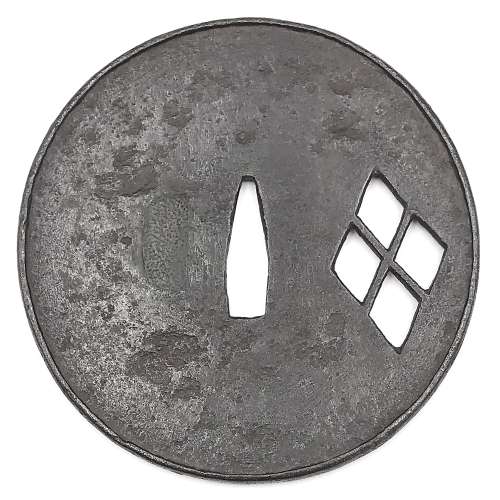 Iron tsuba of round form with design of diamond-shaped family crest (waribishi-mon) in openwork (sukashi). Bevelled, raised rim. Kozuka-hitsu-ana plugged with tin or lead. Ko-Katchushi school. Early Muromachi period: Early 15th century (Oei era). Size: Height: 89.3 mm. Width: 89.0 mm. Rim thickness: 4.3 mm. Center thickness: 2.9 mm. Provenance: Sasano Masayuki Collection, № 41: "In this tsuba, a family crest incorporating four lozenges sits upright on the right side of the nakago-ana. The straight lines of the lozenge add substance and power. Initially, the crest creates confusion regarding the age, yet the overall impression is one lacking in vigor and probably dates rather later than Nanbokucho period".
Iron tsuba of round form with design of diamond-shaped family crest (waribishi-mon) in openwork (sukashi). Bevelled, raised rim. Kozuka-hitsu-ana plugged with tin or lead. Ko-Katchushi school. Early Muromachi period: Early 15th century (Oei era). Size: Height: 89.3 mm. Width: 89.0 mm. Rim thickness: 4.3 mm. Center thickness: 2.9 mm. Provenance: Sasano Masayuki Collection, № 41: "In this tsuba, a family crest incorporating four lozenges sits upright on the right side of the nakago-ana. The straight lines of the lozenge add substance and power. Initially, the crest creates confusion regarding the age, yet the overall impression is one lacking in vigor and probably dates rather later than Nanbokucho period". -
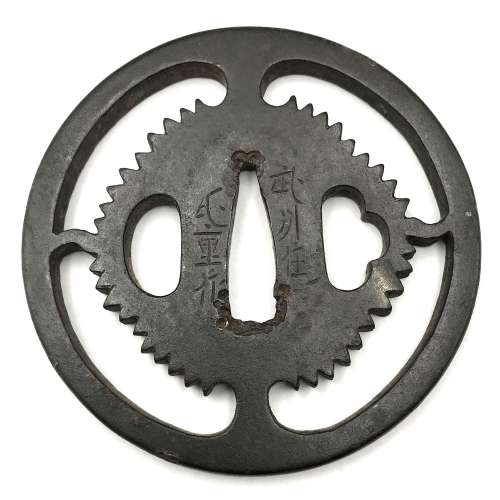 Iron tsuba of round form with slanting rays of light (shakoh) Christian motif (Jesuit's IHS symbol) in openwork (sukashi). Traditional description of this kind of design is called "tokei", or "clock gear". Edo period.
Iron tsuba of round form with slanting rays of light (shakoh) Christian motif (Jesuit's IHS symbol) in openwork (sukashi). Traditional description of this kind of design is called "tokei", or "clock gear". Edo period.Size: 83.4 x 83.1 x 4.4 mm
Signed Bushū-jū Ujishige saku (武州住氏重作) [Markus Sesko]. Ujishige (died 1677), 3rd generation of the Katsuki-Gondayu line; 1st gen. Ujiie came from Kyoto to Kaga to work for the Maeda family. There was another Ujishige, 4th generation Kaneko (?), who died in 1867 [M. Sesko, Genealogies...], but this tsuba looks a bit earlier than that. This particular Ujishige states in his signature that he is from Bushū, or Musashi Province, modern Tokyo Metropolis. He might have moved from Bushū to Kaga, of course. There is no artist with the name Ujishige in Bushū-Ito School anyway.
For information regarding shakoh tsuba see article 'Kirishitan Ikenie Tsuba by Fred Geyer at Kokusai Tosogu Kai; The 2nd International Convention & Exhibition, October 18-23, 2006, pp. 84-91. -
 Katsukawa Shun'ei (勝川 春英; 1762 – 1819).TITLE: Sawamura Sôjûrô III as Kakogawa Honzô.SERIES: Kanadehon Chūshingura (Kana practice book: Treasury of the loyal retainers").DATE: 1795Signed: Shun'ei ga (春英画). Publisher: Iwatoya Kisaburō, Marks 173/p.169. Vertical Ōban: 14.75 x 9.625 inchOn 4th lunar month of 1795 Sôjûrô plays the roles of En'ya Hangan and Kakogawa Honzô in the drama "Kanadehon Chûshingura" at Miyakoza theater in Edo.
Katsukawa Shun'ei (勝川 春英; 1762 – 1819).TITLE: Sawamura Sôjûrô III as Kakogawa Honzô.SERIES: Kanadehon Chūshingura (Kana practice book: Treasury of the loyal retainers").DATE: 1795Signed: Shun'ei ga (春英画). Publisher: Iwatoya Kisaburō, Marks 173/p.169. Vertical Ōban: 14.75 x 9.625 inchOn 4th lunar month of 1795 Sôjûrô plays the roles of En'ya Hangan and Kakogawa Honzô in the drama "Kanadehon Chûshingura" at Miyakoza theater in Edo. -
 Shimizu-Jingo tsuba with a dragon and vajra (on reverse) motif. Unsigned. Possibly, 3rd or 4th master of Shimizu-Jingo family in Higo province. Iron. Low relief carving. Edo period, 1700's. Height: 75.4 mm, Width: 72.2 mm, Thickness at seppa-dai: 4.0 mm
Shimizu-Jingo tsuba with a dragon and vajra (on reverse) motif. Unsigned. Possibly, 3rd or 4th master of Shimizu-Jingo family in Higo province. Iron. Low relief carving. Edo period, 1700's. Height: 75.4 mm, Width: 72.2 mm, Thickness at seppa-dai: 4.0 mm -
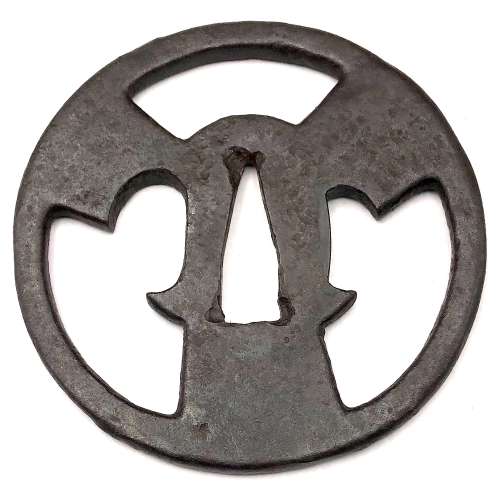 Iron tsuba of round form with three stylized folding fans motif in openwork (sukashi). Kogai-hitsu-ana with shakudō sekigane. Iron bones (tekkotsu) on the rim. Momoyama period or earlier. Possibly, Ko-Shōami school.
Iron tsuba of round form with three stylized folding fans motif in openwork (sukashi). Kogai-hitsu-ana with shakudō sekigane. Iron bones (tekkotsu) on the rim. Momoyama period or earlier. Possibly, Ko-Shōami school.Size: 76.8 x 75.7 x 4.0 mm.
[Seller alleged that the motif is "Buddhist wheel", which seems unlikely. -
 Artist: Katsukawa Shunkō [勝川 春好] (Japanese, 1743 – 1812).
Artist: Katsukawa Shunkō [勝川 春好] (Japanese, 1743 – 1812).Actor: Matsumoto Kōshirō IV [[松本幸四郎]; other names: Omegawa Kyōjūrō, Ichikawa Komazō II, Ichikawa Somegorô I, Ichikawa Takejūrō, Segawa Kinji, Segawa Kingo] (Japanese, 1737 – 1802).
Signed: Shunkō ga. Size: Hosoban; 14 x 33 cm. SOLD -
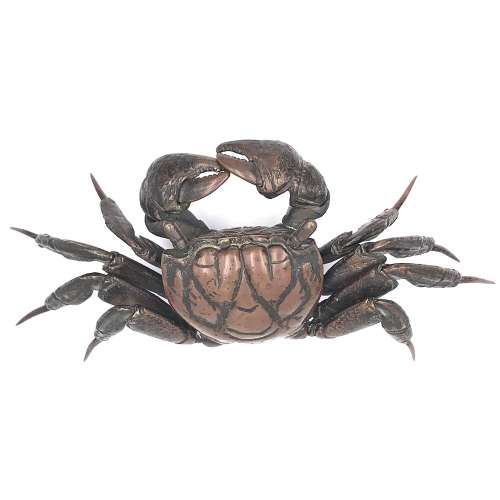 Jizai okimono bronze articulated model of a crab. Japan, Meiji period(1868-1912). Size: Body: 6.5 x 6 cm. Total: 23 x 11 cm. Weight: 762 g
Jizai okimono bronze articulated model of a crab. Japan, Meiji period(1868-1912). Size: Body: 6.5 x 6 cm. Total: 23 x 11 cm. Weight: 762 g -
 Katsukawa Shun'ei. The Sumo Bout between Yotsuguruma (right) and Yamaoroshi (left). Date: 1800 or 1805/06. Similar sheet can be found at Edo Tokyo Museum. Size: Vertical Ōban. Sumo wrestler Yotsuguruma Daihachi (1772 - 1809) first appeared in the records of national tournaments in winter of 1794. Then he lost 3 matches and won zero. He first won in the spring tournament of 1797 in a match against maegashira (the fifth-highest rank of sumo wrestlers) named Kougamine. Yamaoroshi Gengo (born 1762) came in at the winter tournament of 1799 . He was much more successful in his career than Yotsuguruma, but he had never won a tournament. It was the time of great Raiden, who won most of them. In the spring tournament of 1800 Yotsuguruma and Yamaoroshi fought against each other for the first time. Yotsuguruma lost. The next time they met on the ring was at the winter tournament of 1805, and again in 1806. Both matches were won by Yamaoroshi. Yamaoroshi retired in 1809; Yotsuguruma died in 1809.
Katsukawa Shun'ei. The Sumo Bout between Yotsuguruma (right) and Yamaoroshi (left). Date: 1800 or 1805/06. Similar sheet can be found at Edo Tokyo Museum. Size: Vertical Ōban. Sumo wrestler Yotsuguruma Daihachi (1772 - 1809) first appeared in the records of national tournaments in winter of 1794. Then he lost 3 matches and won zero. He first won in the spring tournament of 1797 in a match against maegashira (the fifth-highest rank of sumo wrestlers) named Kougamine. Yamaoroshi Gengo (born 1762) came in at the winter tournament of 1799 . He was much more successful in his career than Yotsuguruma, but he had never won a tournament. It was the time of great Raiden, who won most of them. In the spring tournament of 1800 Yotsuguruma and Yamaoroshi fought against each other for the first time. Yotsuguruma lost. The next time they met on the ring was at the winter tournament of 1805, and again in 1806. Both matches were won by Yamaoroshi. Yamaoroshi retired in 1809; Yotsuguruma died in 1809. -
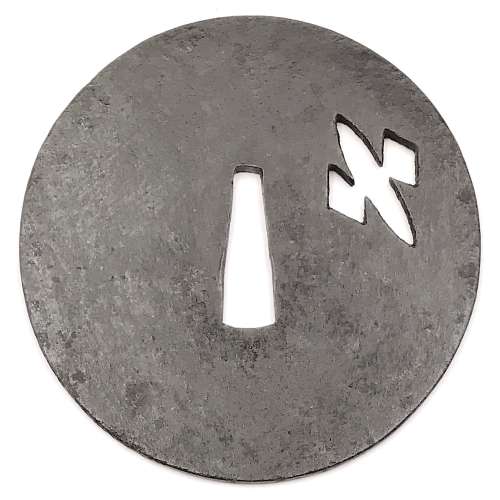 Iron tsuba of round form with design of triple diamond (matsukawa-bishi) in openwork (sukashi). Square rim. Ko-Tosho school. Nanbokucho period: Late 14th century (Oan/Eiwa era). Height: 92.3 mm. Width: 92.3 mm. Rim thickness: 2.5 mm. Center thickness: 3.0 mm. Provenance: Sasano Masayuki Collection, № 15: "Two small lozenges are attached to each end of a larger lozenge. Most Ko-tosho tsuba have inspirational designs, however this has a rather casual appearance, although it represents the unstable political situation at the time".
Iron tsuba of round form with design of triple diamond (matsukawa-bishi) in openwork (sukashi). Square rim. Ko-Tosho school. Nanbokucho period: Late 14th century (Oan/Eiwa era). Height: 92.3 mm. Width: 92.3 mm. Rim thickness: 2.5 mm. Center thickness: 3.0 mm. Provenance: Sasano Masayuki Collection, № 15: "Two small lozenges are attached to each end of a larger lozenge. Most Ko-tosho tsuba have inspirational designs, however this has a rather casual appearance, although it represents the unstable political situation at the time". -
 Relatively thick iron tsuba of rounded square form with slightly elevated rim decorated in carving (sukidashi-bori) and yellow brass (shinchū) inlay (suemon-zōgan) with legendary creatures (humans with cow heads) in a pine tree forrest on the face, and a horned man with a stick hunting a rabbit in the woods on the reverse. Large hitsu-ana possibly cut off later on. In the beginning of the 20th century such tsuba were usually attributed to Fushimi-Kaga school. This one may be attributed to either Ōnin or to Heianjō. The latter seems most plosible because of the thick web and dull patina. The technique may also be called "shinchū-zōgan". Momoyama or early Edo period. Unsigned. Dimensions: 72.3 x 68.4 x 4.1 mm
Relatively thick iron tsuba of rounded square form with slightly elevated rim decorated in carving (sukidashi-bori) and yellow brass (shinchū) inlay (suemon-zōgan) with legendary creatures (humans with cow heads) in a pine tree forrest on the face, and a horned man with a stick hunting a rabbit in the woods on the reverse. Large hitsu-ana possibly cut off later on. In the beginning of the 20th century such tsuba were usually attributed to Fushimi-Kaga school. This one may be attributed to either Ōnin or to Heianjō. The latter seems most plosible because of the thick web and dull patina. The technique may also be called "shinchū-zōgan". Momoyama or early Edo period. Unsigned. Dimensions: 72.3 x 68.4 x 4.1 mm -

Kitagawa Tsukimaro (Kikumaro): 喜多川 月麿, fl. c. 1794–1836.
Mother is playing with her child: they left playing with shadow lantern for freeing a turtle (Hojo-e, or "Rite for the Release of Living Beings").Signed: Tsukimaro hitsu (月麿筆); Publisher's mark; censor's seal: Kiwame + Yamaguchiya Tôbei gyōji seal (1811-14).
-
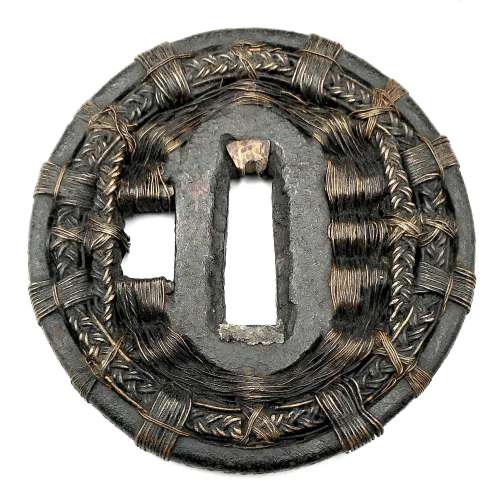 Shingen school tsuba with woven wire pattern. Iron core, woven brass wire. Height: 72.5 mm; Width 69.8 mm; Thickness at seppa-dai: 4.0 mm. Weight 88.8 g. Late Muromachi, 16th century. SOLD http://varshavskycollection.com/shingen-tsuba/
Shingen school tsuba with woven wire pattern. Iron core, woven brass wire. Height: 72.5 mm; Width 69.8 mm; Thickness at seppa-dai: 4.0 mm. Weight 88.8 g. Late Muromachi, 16th century. SOLD http://varshavskycollection.com/shingen-tsuba/ -
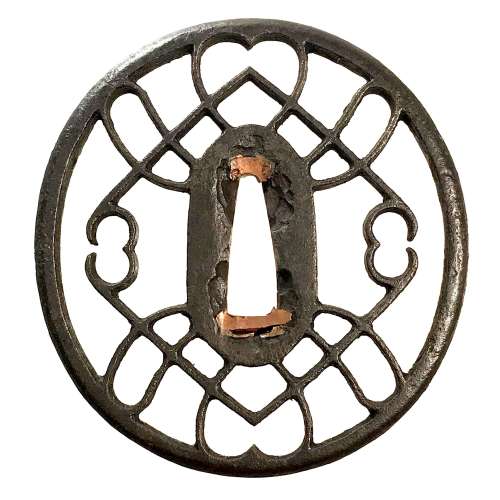 Iron tsuba of oval form with the motif of horse trappings in openwork (sukashi). Copper sekigane. Iron bones (tekkotsu) on the rim.
Iron tsuba of oval form with the motif of horse trappings in openwork (sukashi). Copper sekigane. Iron bones (tekkotsu) on the rim.Size: 80.4 x 75.8 x 5.2 mm
NBTHK Certificate №454567, allegedly saying that it is Akasaka School, Muromachi period. A look-a-like tsuba in Robert. E. Haynes Catalog #7, 1983 on page 57 under №48 is described as follows: "A masterpiece second period Owari sukashi tsuba. The plate is of beautiful color and quality almost like velvet. The design is very hard to discern, it might be the horse trappings, or even a moon. The style and type of Owari tsuba shows the great tradition of the Momoyama period and why it was the renaissance in time, as well as the arts produced, through the long history of all Japanese art. Ca. 1580. Ht. 7.7 cm, Th. (center) 5.5 mm, (edge) 5.25 to 5.75 mm."I believe we can safely attribute this tsuba to Owari School, c. 1580.
Robert. E. Haynes Catalog #7, 1983, p. 57, №48.


